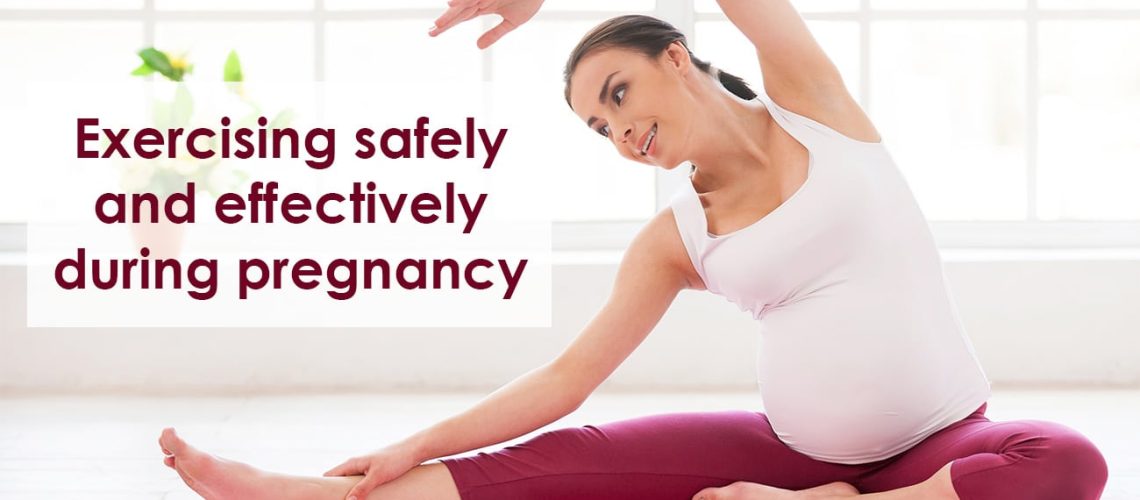

Dahlas Fletcher
How to approach exercise safely and effectively during pregnancy
By Dahlas Fletcher, Certified Pregnancy & Postpartum Exercise Specialist
It wasn’t all that long ago that when women fell pregnant, they were told to take it easy and do nothing strenuous. Today, this approach has changed and really makes no sense; especially when many women have to go about their busy days as usual which often includes lifting groceries and toddlers!
The current guidelines on exercise during pregnancy say women should aim for between two and a half and five hours of activity with “moderate intensity”a week. This means a pregnant woman should be moving for at least 30 minutes a day, most days of the week. If you have never exercised before, when you fall pregnant, try to start slowly and work your way up. If you are feeling good and following a safe and effective exercise regime, it is also okay to continue to work out right up until your due date.
Can I use a treadmill when pregnant?
Yes, you can exercise on a treadmill while pregnant. Walk or jog at the same pace you normally would but keep an eye on your heart rate and balance. Learn about the ‘Talk Test‘ to keep you and bub safe during pregnancy.
Quality not Quantity
When exercising during pregnancy it is important to think about quality over quantity. The old fitness adage of “go hard or go home” or exercising until you are red faced and depleted, is not applicable during pregnancy. Instead, using movement during pregnancy is a wonderful opportunity to connect both physically and mentally to your changing body. This will not only give you and your growing baby numerous benefits but also ensure a better recovery postpartum.
All pregnant women should check with their doctor or medical practitioner before starting an exercise program. Women with certain pregnancy complications – such as pre-eclampsia, incompetent cervix, uterine bleeding and low-lying placenta in late pregnancy – are likely to be advised to avoid exercise completely.
Pregnant women should also make sure to avoid certain types of exercise that could harm their unborn babies. This includes anything with risks of falls or collisions – skiing, horse-riding, martial arts, contact sports or high impact. On top of that, women should know the signs that they need to stop exercising. Among these are abnormal bleeding, unexplained chest pain, pelvic floor heaviness and feeling faint or dizzy.
What types of exercise are best during pregnancy ?
According to the Royal Australian and New Zealand College of Obstetricians and Gynaecologists (RANZCOG), pregnant women should be doing a mix of aerobic exercise / cardio and strength training. Here’s a rundown:
Cardio Training
Traditionally when the word “cardio” is used many immediately think of “high impact” exercises such as running, aerobics or boxing ! However, cardio is any form of movement that increases respiration and heart rate. This can also get a little confusing during pregnancy due to the myth that during pregnancy a woman’s heart rate should not be increased to over 140 BPM. This is now outdated advice – The official ACOG guidelines currently recommend the “talk test”, meaning a pregnant woman should be able to hold a conversation while exercising. When this occurs then both the pregnant woman and baby are in a safe range during exercise.
Walking during pregnancy
Walking at a moderate pace where a conversation can still be held is an excellent form of cardio exercise during pregnancy. Using a treadmill for a “walking workout” during pregnancy also has many benefits. An indoor environment can help avoid overheating, especially during the summer. The use of a treadmill also allows better control of pace and impact as a variety of levels can be adjusted on a treadmill and the treadmill footing creates a more cushioning impact. During pregnancy, it is also important to monitor the time spent walking. Excessive long power walks during pregnancy with poor posture (e.g. leaning over a pram) can trigger a condition called pelvic instability. Time and posture can be better controlled on a treadmill.
NOTE: Our Breakfree treadmill is the ideal treadmill for pregnant women looking to use it for walking or light jogging.
Pregnancy resistance training
Resistance training is wonderful during pregnancy as improves muscle tone and bone density. Plus improving total body strength during pregnancy is an important way to lessen or prevent common pregnancy aches and pains. Resistance training includes forms of movement using light weights, resistance bands and also safe bodyweight exercises (including swimming as the water creates a natural resistance).
It is recommended if using weights during pregnancy that resistance is reduced to about a 7 out of 10 or 70% if you are a regular lifter. Please consult a certified pregnancy trainer so they can guide you through an appropriate resistance training program.
Core training during pregnancy
Core training during pregnancy is also essential. This does not mean the traditional core or ab exercises such as plank, crunches, sit ups or Russian twists! These are not a safe and effective option when a baby is inside the womb. Instead, focusing on deep core exercises that will enhance birth and help women connect better to their pelvic floor are important during pregnancy. Using a combination of breath and specialised total body movements including Pilates based moves are a great way to achieve this. During pregnancy and post birth it is important to look for any abdominal coning or doming as this is information from the body that the exercise or core movement is not safe. A woman’s abdominals need to separate during pregnancy to make way for the growth of a baby. It is important to ensure this separated area (or linea alba) is not damaged during pregnancy and is the best way to avoid diastasis recti or the dreaded postpartum pooch!
In Summary
Exercise during pregnancy is a positive decision and does not need to be complicated and exhausting. Go for movements that makes you feel better and improves your energy levels rather than depleting you. With a regular and safe exercise routine during pregnancy you should sleep better, have less aches and pains and, research has proven, a shorter birth and recovery period.
If you can, try to embark on some form of exercise before you fall pregnant. This is going to make it much easier to stick to an exercise routine during and after your pregnancy. You will also be more physically prepared when your newborn arrives and be less prone to injury when exercising during pregnancy.
Simply start with 10 mins, 2 – 3 times per week tune into your body and go from there!
Treadmill While Pregnant FAQs
What speed should I walk on the treadmill while pregnant?
Gone are the days when a heart rate monitor needs to be worn during pregnancy exercise to ensure your heart rate does not raise above 140 bpm ( this recommendation was removed in 1994 from the ACOG guidelines) . The best way to find out if you are exercising at a suitable pace (including on a treadmill) is to ensure you can hold a comfortable conversation. This is called the “talk test”. If you can do this then both you and your baby are in a safe range during exercise.
Can walking on treadmill cause miscarriage?
If you are exercising at a safe pace (see above) there is no evidence that walking on a treadmill will cause a miscarriage.
Can I exercise on a treadmill in the first trimester?
Yes you can. However the first trimester can come with exhaustion and nausea. If you are not feeling 100% please ensure your exercise routine is gentle. Some women find that gentle movement actually helps to improve nausea and exhaustion.
Can running while pregnant hurt the baby?
Running during pregnancy won’t hurt your baby, but it can compromise your pelvic floor.
If you feel heaviness, or have lower back pain, incontinence or hip pain when running (or during any forms of exercise) it is advised you stop and get assessed by a Women’s Health Physiotherapist.
Dahlas Fletcher
Dahlas Fletcher is one of Australia’s most respected and successful certified and experienced Pregnancy and Postnatal Trainers.
Her achievements include:
– Owner of Preggi Bellies QLD Specialised Pregnancy/Postnatal Group Exercise Training
– Burrell Education – Modern Pregnancy Exercise Integrated Core & Functional Training (Globally Certified for UK/USA Pregnancy Training)
– Australian Fitness Network Certified Pregnancy & Post Natal Exercise
WEBSITE : www.bodyfabulous.com.au
Instagram : www.instagram.com/bodyfabulouspregnancy
Facebook : www.facebook.com/BodyFabulous/
DISCLAIMER: This information is intended to be used as a guide of general nature, having regard to general circumstances. The information presented should not be relied on as a substitute for medical advice, independent judgement or proper assessment by a doctor, with consideration of the particular circumstances of each case and individual needs. This information reflects information available at the time of its preparation, but its currency should be determined having regard to other available information.